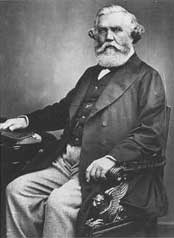Editor, H. S. (2002;2002). BAR 21:01 (Jan/Feb 1995). Biblical Archaeology Society.
DID KING JEHU KILL HIS OWN FAMILY?
New interpretation reconciles Biblical text with famous Assyrian inscription
By TAMMI SCHNEIDER
One of the most dramatic finds ever made relating to the Bible is the famous Black Obelisk of the Assyrian king Shalmaneser III (ruled 858–824 B.C.E.), excavated by Austen Henry Layard at Nimrud in 1846 and now prominently displayed in the British Museum.

|
Hulton Deutsch Collection Limited
Sir Austen Henry Layard (1817–1894) began his excavations in November 1845 in Nimrud, where he thought he had discovered the remains of ancient Nineveh. In fact, he had found Kalhu (known as Calah in Genesis 10:11–12 ), capital of the Assyrian king Assurnasirpal II, who ruled from 883 to 859 B.C.E. Kalhu remained the capital of Assyria for 150 years. Among Layard's finds in Nimrud, which he explored until 1847, was the Black Obelisk. He returned to Nimrud in 1849, and later moved to Nineveh, where he discovered Sennacherib's palace. Layard's field-work came to an end in 1852 with the onset of the Crimean War.
|
The four-sided limestone monument is decorated with five registers of relief sculptures depicting the bringing of tribute to Shalmaneser. Each register reads around four sides, one panel to a side, portraying a particular tribute and tribute-bearers. The second register from the top shows the tribute of the Israelite king Jehu (ruled 841–814 B.C.E.). The central figure on the first panel of this register, presumably Jehu himself, prostrates himself, forehead to the ground or possibly kissing the feet of the Assyrian monarch. Some have suggested that this figure might be Jehu's emissary. But if it is Jehu, this panel offers the only extant picture of a king of ancient Israel from the First Temple period.
The cuneiform caption above this register identifies the scenes as representing the tribute of Jehu and reads as follows:
"Tribute of Iaua [Jehu], son
of Omri. Silver, gold, a
golden bowl, a golden
beaker, golden goblets,
pitchers of gold, tin, staves
for the hand of the king,
[and] javelins, I
[Shalmaneser] received from
him."1
Before Jehu is Shalmaneser himself, beneath the winged symbol of the Assyrian god Assur. Behind him stand two retainers, one protecting him from the elements with a shade. Jehu's attendants stand behind the Israelite monarch with tribute in hand.
The Bible does not mention Jehu paying tribute to Shalmaneser. But obviously the Bible does not record everything that occurred in a reign that began in 841 B.C.E. and ended in 814 B.C.E.
1 D.D. Luckenbill, Ancient Records of Assyria and Babylonia 1 (Chicago, 1926–1927), para. 590; see also James B. Pritchard, Ancient Near Eastern Texts Relating to the Old Testament , third edition (Princeton: Princeton Univ. Press, 1969), p. 280.
next page >
page 1:10
 
|
Biblical Archaeology Review
This article is part of the Biblical Archaeology Review Archive CD-ROM. Click here to learn more.
|
|